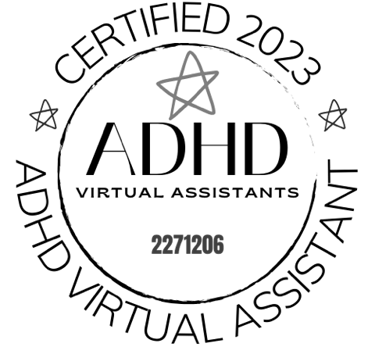Navigating the Storm of RSD
A professional woman meditates in a lotus position against a pink background with a rollercoaster. Text: "Pressing pause on the panic."


A Practical Guide
You finish a client call. The feedback was constructive, minor.
But as you hang up, the feeling hits - a gut-wrenching, cold wave. Your heart hammers.
Your thoughts spiral: They hated it. I’ve failed. The project is ruined.
This is Rejection Sensitive Dysphoria (RSD) and for the ADHD entrepreneur, it can feel like a professional emergency.
The reactions are very real but it is often a false alarm.
This guide moves from understanding that alarm to building systems that lower the volume, helping you respond with clarity, rather than panic.
Understanding Your RSD Alarm – Pressing Pause on the Panic
RSD is a neurological response, not a character flaw.
Think of your brain’s threat-detection system. In many neurodivergent individuals, this system is wired to a high - sensitivity alarm for social and rejection-based threats.
A perceived slight, a delayed email or constructive criticism can trigger a flood of stress chemicals as if you were facing a genuine survival threat.
The first, most powerful skill is to insert a moment of space between the trigger and your reaction.
This starts with labelling.
When you feel that familiar, crushing plunge, your internal script must be:
"This is my RSD. The feeling is real but the threat level is likely not."
Naming it robs it of its anonymous power. It’s the mental equivalent of recognising a fire drill for what it is - loud and alarming but not a true catastrophe. This pause is the foundation upon which everything else is built.
Short-Circuiting the Spiral
When the RSD wave hits, your executive functions can feel offline.
A pre-rehearsed cognitive script acts as a lifeline, giving your brain a structured path to follow out of the chaos.
Pause and Breathe.
Before you do anything - especially before you hit "reply" - stop.
Take one deep, intentional breath.
This isn't woo - woo; it’s a biological circuit breaker that can begin to dampen the stress response and give you a crucial second of clarity.
Label and Neutralise.
Acknowledge what is happening internally.
Use a clear, calm phrase like:
"My RSD is activated. This feeling is intense but temporary."
This separates "you" from the "emotional storm," allowing you to observe it rather than be consumed by it.
Seek the Data, Not the Drama.
Ask yourself: "What are the factual, neutral details of this situation?"
Strip away the emotional narrative. If a client says, "I have some feedback on the proposal," the data is: "They have feedback."
The RSD narrative might be: "They hated it, I've failed, they're going to fire me."
Anchor yourself to the provable facts.
Choose a Small, Concrete Action.
Instead of ruminating, decide on one tiny, physical next step.
This could be: "I will file this email in my 'For Feedback Review' folder," or "I will take a five - minute walk."
Action, however small, moves you from a passive victim of emotion to an active manager of the situation.
This script doesn't make the feeling disappear but it prevents it from hijacking your judgement and derailing your hour or your entire day.
Automate the Ask, Ease the Anxiety – The System Template
While scripts manage the immediate fires, proactive systems fireproof your business.
The goal is to design your workflows to minimise the frequency and intensity of RSD triggers, creating an environment where your brain feels safer.
Automate the Vulnerable Asks.
The act of following up on an invoice or asking for a testimonial can feel intensely personal and ripe for rejection.
Remove the emotional labour by creating templates. A simple, polite, pre-written email for these situations standardises the process.
You're not crafting a personal plea each time; you're executing a calm, business-as-usual system.
This reframes the ask from a personal favour to a standard administrative task.
Schedule a "Feedback Review" Session.
Instead of letting feedback ambush you in your inbox, contain it.
Schedule a specific, 30 - minute window once or twice a week to process all feedback.
When a comment comes in, you can acknowledge it and then immediately file it away for your dedicated session.
This simple system gives you time for the initial RSD wave to subside, allowing you to approach the feedback from a calmer, more analytical headspace.
Create a "Win Folder."
Your brain is wired to remember the negative. Fight this inherent bias with a deliberate system.
Create a folder in your email or a document where you save every piece of positive feedback, thank you note and successful completion.
When RSD strikes and tells you you're a failure, you have a curated, undeniable body of evidence to the contrary.
This is not vanity; it's strategic data collection for your mental resilience, a tangible reminder of your competence and value.
Managing RSD is not about becoming immune to feeling. It is the ultimate act of turning chaos into clarity: building a more robust operating system for your business and your brain.
By combining immediate cognitive first-aid with long-term, proactive systems, you transform RSD from a disruptive, shameful secret into a manageable aspect of your neurodivergent profile.
You learn to feel the storm without letting it capsize your ship, ensuring that you and not your RSD, remain the calm, capable captain of your business.
If you are feeling hijacked by your to-do list and your emotions - if your brain refuses to start until panic hits, let’s get your next month structured and fireproofed.
Book a Power Hour with me. We'll create a system that works with your brain, not against it.
https://www.lanza-va.com | Lanza‑VA – ADHD‑Friendly Virtual Assistant, London UK
Registered business address available on request. Based in North London, United Kingdom.


© 2023 to present. Lanza‑VA | All Rights Reserved
Your data security is my priority. I adhere to stringent security protocols and exercise the highest discretion with confidential information.
This site is protected by reCAPTCHA and the Google Privacy Policy and Terms of Service apply. | Privacy Policy | Terms of Service
